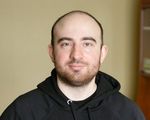About Success Builder
How do you find your place in life? How do you find something to do that both comes naturally to you and makes you happy? The answer is that you have to apply the knowledge you’ve gained from university and from life itself correctly. The Success Builder Project features HSE University graduates who have discovered themselves through an interesting business or an unexpected profession. The protagonists share their experiences and lessons learnt and talk about how they’ve made the most of the opportunities they were given.
The new workout culture has brought new popularity to the lonely pull-up bars that stand in residential neighborhoods across the country. Now thousands of people have discovered that they can get into shape easily, at no cost, and by working out as little as 10 minutes per day. WorkOut City Streets Fitness founder Anton Kuchumov explained how he turned street workouts into a social project, how he is getting Russia’s nuclear power plant employees in shape, and why he is no fan of fitness clubs.
Do you consider yourself an athletic person?
I work out on pull-up and parallel bars, of course, but sports per se are not my main interest. WorkOut is more of an educational project.
Why didn’t you pursue a career in your area of specialization?
During the final part of my Master’s programme, I did some work for an IT company that develops electronic statistics and data management projects for major brands. Within a few years, I rose to the level of project director, and I was happy with just about everything there. But I understood that developing my own project was a completely different level that would bring me far more useful and interesting experience. I started the [WorkOut] project while still at my job, but once I realised that it could support me financially, I decided to devote all my time to it.
Did you consider the risks at that point? After all, you could have wound up with nothing.
When you do a social project, you don’t risk anything: you can always go back to your day job.
Would you say that your education in management has given you a useful life skill?
Management does a great job of combining such technical disciplines as probability theory, mathematical analysis and statistics, on the one hand, with the humanities on the other hand. The result is a comprehensive education. Some of it has practical application in your life and some does not, but it opens a wide array of options. You can easily go to work in a variety of fields, which is really cool. While at the IT company, I worked with the technical side, but also interacted successfully with the “live component” —people. What management gives you is the flexibility and ability to adapt—that are important in a shifting economic environment.
How did you get the idea for WorkOut? Was it difficult to execute?
Friends and I saw some videos on the Internet in which Americans were working out on pull-up bars, and we were amazed at how much you could do by just using some imagination. Back then, in 2009, people mostly used the bars to beat their carpets on, and when we got together to exercise on the outdoor equipment, the police would sometimes hassle us, calling us a “suspicious looking gang.” But for us, it only served as a catalyst to draw attention to regular, and more importantly, accessible physical activity that produced results.
The first time we got together for a workout, 15 people showed up. Within three months, 50-60 people in Moscow alone would work out with us. With the help of social networks, guys in other cities also became interested in the workouts, and like-minded people joined not only in Russia, but also in Ukraine, Belarus and Kazakhstan.
It is usually very expensive these days to promote a project on social networks. How did you solve this problem when you were starting out?
We did not spend a single ruble on promotion. In 2009, you could post your idea to what was still a practically empty informational space. Even YouTube was almost empty in terms of Russian-language sports and fitness videos, and people found the topic interesting and relevant, so it was easy to gain popularity quickly. Facebook—much less VK—had yet to introduce algorithms limiting the scope of the audience for posts. Our project’s experience provides a good example of how abominably the social networks have evolved and how tough the have become in their business practices.
How did you go from informal street workouts to a highly structured project?
Starting in 2011, interest began to wane and we began thinking about how to reformat the project to turn it into a system and scale it up. We began developing the SOTKA 100-Day Workout programme, and now the workout culture mostly develops through that. The 100-Day Workout is a structured, free product aimed at people ages 20 to 70 who want to get into shape but don’t know where to start. For 100 days, we give participants all the necessary information for their level of physical fitness.
If a person follows all of the recommendations, the result will be equivalent to earning a silver or gold GTO (‘Ready for Labour and Defense’) badge in their age category
What is the educational aspect of this project?
We provide people with all of the necessary information about physical activity and a healthy lifestyle in general. We tell them what food consists of, what proteins, fats, and carbohydrates are, why calories are consumed, how metabolism works, etc. We do this, in part, to clear the Internet of clutter on this topic. The Internet has become a drainage ditch for false information on the subject of weight loss, with individuals and companies hyping trends for their own benefit. ‘Do you want to lose weight? Then eliminate carbohydrates, don’t eat after 6 pm, take handfuls of supplements, etc.’ The energy conversion process is not very complicated—even though different bodily systems, including hormonal, are involved—and you need to know how it actually works to avoid falling victim to marketing schemes.
All of the information for the SOTKA 100-Day Workout is taken from scientific sources, ranging from grammar school textbooks on chemistry, physics and biology to the very latest publications by scientists. Quite a few members of the scientific community as well as professional athletes participate in the programme and they provide us with feedback that we use to modify and improve the programme twice a year. For example, we began telling people a lot about biomechanics and load distribution for different parts of the body. Having this knowledge gives people more opportunities in their workouts and, in general, they become more conscious of how their bodies work.
Can you tell us about the project’s team members?
We have workout facilitators in 30 cities and five countries who conduct the workout sessions, bring in new participants and work with newcomers. All of this is free. These are people whose lives have been changed by the workouts and they just want to “give back” what they’ve received from the project. People become discouraged with traditional fitness programmes because they pay a lot of money for them and get few results. But when you see how someone you know has gotten himself into shape—and at no cost—people just begin to trust the project and want to support it.
Who conducts the workout sessions?
No trainer can help you if your mind isn’t “plugged in.” Each person answers for himself and learns to understand his own body. Our job is to develop their self-reliance—something that is sorely lacking in today’s world. And this requires only 20-30 minutes a day, instead of the exhausting and completely unnecessary workouts that various fitness organizations sell. Scientists have proven that it isn’t the length of the workout, but the correct load distribution over time that’s important.
Where does money come into the picture? Word has it that you plan to earn $1 million from WorkOut in 2019.
Our earnings come from selling the workout equipment for the project. No one earns anything from the workouts themselves.
I hold the position that knowledge is not a commodity, and that it should be distributed at absolutely no cost
On the other hand, as the popularity of the workout culture has grown, we have received more and more requests from people for specialised equipment—gloves to protect against calluses, weighted vests, and so on. The number of items we sell has gradually increased and we currently have about 20, but we still prefer to remain a niche company that is thoroughly familiar with its own product line and is one of the world’s leading experts. People appreciate this, and now not only ordinary workout buffs, but also major Russian fitness chains, sports teams, state structures and educational institutions purchase our products. All of the money received through our store goes to developing the workout culture.
Do you feel like a businessman?
No, more like a social entrepreneur. Every bit of commercial success means more opportunities for the project itself—and that means greater benefit for society. My goal is not to make money, but to change the world and make people more self-reliant and aware.
What should a person know before starting a socially conscious business?
Don’t start a social project with only an idea and some desire: that is an abstraction and a dead-end. You should first go to work in a company that has already succeeded in your area of interest. This will give you new contacts that will prove useful. And you will see which problems exist that the business you have in mind could address. Only then will there be a demand for it.
A number of HSE students work out on your equipment. Where else have you managed to popularise WorkOut?
Our entry into the university and other structures came about thanks to the initiative of people who had gone through the programme. For example, a guy from MIPT invited his friends to work out with him so that he wouldn’t be bored doing it alone. Then they asked the administration to build a workout area for them and a whole healthy lifestyle movement was born at the institute. Employees of the Kurchatov Institute are also involved in the project. The head of a laboratory there had gone through our programme. He first invited members of the lab staff, and then decided that his other co-workers could also start exercising. And it was pretty much the same story with HSE and the Energia rocket factory. In addition, the programme has already been implemented at two Rosenergoatom nuclear power plants (NPP), for both workers and residents of the nearby cities. And we are in the process of launching the programme at three more NPPs.
Why are NPP workers so interested in working out on pull-up bars?
An employee of the Kursk NPP who had completed the 100-Day WorkOut programme and who happened to attend one of my lectures on social entrepreneurship decided to become a facilitator of the programme in his city. It all started with that. It is a tradition of sorts to maintain your health in less than favorable conditions. And besides, the programme requires only minimal conditions and a minimum of time, and it provides an understanding of how to maintain your health even if you are not into sports. For the NPP staff, it is also a form of teambuilding because it is interesting and reinforces team spirit.
It turns out that WorkOut is a kind of rival to commercial fitness centres. What’s wrong with the prevailing business approach to healthy lifestyles?
The problem is the model itself. A fitness club trainer is more interested in having a long-term client than in achieving positive results and makes recommendations that are money-oriented. CrossFit, for example, is a totally useless system—but it is very entertaining. What’s more, it’s fashionable, and if you tell someone that you’re into CrossFit, you have the satisfaction of hearing them say, “Wow!”
WorkOut, in this regard, is like a school in which you build a relationship with your body step by step and receive a well-rounded education. They say: ‘A strong tree grows slowly’ —but who cares if someone promises fast and fabulous results for money?
In the WorkOut culture, Instagram and other forms of self-adulation are not very popular. We don’t see the point in all that
How will the project develop in the coming years? What are your goals?
Our app has been installed more than 250,000 times and we plan to double that number by next summer. We are translating the SOTKA 100-Day WorkOut into English because it turns out that there are no other projects like it at the international level. For now, we’re the “App of the Day” only in the Russian AppStore, but we plan to launch in the West as well.
Can WorkOut change a person’s life?
You start working out. That gives you strength, and the strength gives you confidence that you can use in any area of life. Everything is simple. The most important thing is to do it. Even if you don’t see results at first, keep going in the knowledge that you will move forward and achieve your goal.
We don’t like being called athletes. We just do this for ourselves and to help others. We take an active social position and everyone can do the same. Our task is to teach people to be active and to give them the necessary tools. For example, I am deeply convinced that everyone needs physics, mathematics and biology because we consist of these things and all our bodily systems work according to physical laws. I don’t care much for technology: it distracts us from what is substantial, from what is constant and unchanging. And when I turn off the Internet, something happens—I suddenly discover that I’ll survive without it. I now live almost entirely in “airplane mode”—I’ve turned off all the notifications on my phone to avoid distractions.













































































































































